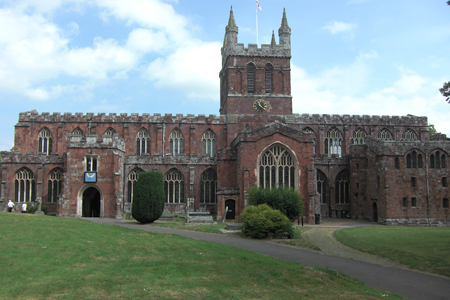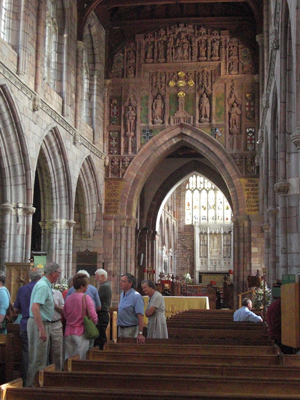| |
 |
 |
 |
| Comment on this report, or find other reports. |
 |
| Our Mystery Worshippers are volunteers who warm church pews for us around the world. If you'd like to become a Mystery Worshipper, start here. |
 |
| Find out how to reproduce this report in your church magazine or website. |
|
|
| 2020: Holy Cross,
Crediton, Devon, England |
 |
 |
 |
Mystery
Worshipper: Traveller.
The church:
Collegiate Church of the Holy Cross and the Mother of Him
who Hung Thereon, Crediton, Devon, England.
Denomination:
Church of England,
Diocese of Exeter.
The building:
This mouthful of a title (the locals just call it "Holy Cross")
shows that it was a collegiate church in antiquity, which
explains the strange arrangement of the central tower with
the east end almost as long as the west. The present building
is largely perpendicular in style, dating from the 15th century,
although there are much earlier elements in parts of the building.
The red hue of the building comes from the local stone, which
is repeated in the red soil of the area. The interior is spacious
and well-lit, as most of the windows at ground and clerestory
level are of clear glass.
The church:
The Church of England in Devon last year celebrated 1,100
years of the county having its own diocese; this being carved
out of the earlier, massive see of Sherborne. The current
diocese of Exeter, however, is the newcomer. The original
bishop Eadulf in 909 sited his cathedral in Crediton and the
see remained here for nearly 150 years until bishop Leofric
(also Lord Chancellor of England) petitioned the Pope and
the King in 1046 to remove the see to Exeter, just eight miles
away. Life was not quiet in those 950 years, what with various
plagues and famines, even if the Civil War mostly passed by
the town. The collegiate foundation was changed in 1547 to
an unusual charter from Edward IV (still current) granting
12 governors all rights to the church and grammar school,
and related charters from the bishop and cathedral chapter
in Exeter relinquishing all claims to the goods of the church.
The neighbourhood:
Crediton is now a pleasant sleepy rural market town a few
miles to the north of Exeter, with a main street populated
with independent shops, rather than branches of big chains
that give so many towns a look-alike feel.
The cast:
The Revd Catherine Carlyon was the celebrant, and the Revd
Sue Martin preached.
Date and time:
Sunday, 27 June 2010, 9.30am.
What was the name of
the service?
Sung Eucharist.
How full was the building?
About 120 in the congregation. It felt comfortably full for
a Sunday service, with most pews occupied, although more bodies
could easily have been fitted in. The church now uses a nave
altar,with the choir positioned behind this and the choir
stalls positioned under the tower, so the east end was unused.
Did anyone welcome you personally?
The happy bustle of people just inside the door included a
couple of stewards with armsful of packages of hymn books,
service leaflets, newssheets and readings. We received a big
smile and a cheery "Good morning" with the proffered package.
Was your pew comfortable?
The standard wooden pew was spacious and comfortable enough
for the period of the service. The ledge in front was, like
so many of its sort, too narrow to hold a hymnbook and related
paperwork securely.
How would you describe the pre-service
atmosphere?
Happy and relaxed on that warm summer's morning. People were
gently moving around and chatting, without intruding on anyone
who wished to contemplate the coming devotions. The church
boasts an impressive ring of bells (augmented to 12 in 2007)
in the squat central tower, and these were completing their
call to prayer when we arrived and could be clearly heard
inside the church.
What were the exact opening words of the
service?
"Good morning and welcome to Holy Cross."
What books did the congregation use during the
service?
The parish has produced a booklet with their words for conducting
a Common Worship sung eucharist, which also has the music
(melody line) of the setting of the service. (This is a great
idea and big advantage for musical visitors like ourselves;
the church gets a huge numbers of brownie points for this.)
The New English Hymnal was used for the hymns, a
weekly newssheet for the notices, and a commercially produced
sheet with collect, readings and psalm for the day.
What musical instruments were played?
A three-manual Harrison & Harrison organ, originally built
in 1921 and fully restored in 2001, supported the music throughout.
The organ loft occupies the north transept, so the console
sits behind the choir, cantoris side.

Did anything distract you?
We did not know the arrangement of the church when we arrived
and tried to find a discreet part to sit where we could see
and hear, but not be obtrusive. We chose a pew close to the
font, which turned out to be the position of the crèche.
Their (mostly) happy noise was the most distracting thing
about the service. (Do not think of this as a criticism! I
think kids belong in church and well remember the effort to
keep my own children reasonably quiet there.)
Was the worship stiff-upper-lip, happy clappy, or
what?
Middle-of-the-road Anglican. No bells, no smells, no genuflection, but robes and ceremonial enough to set the time apart as a devotional offering. Notable in the entry procession was the choir, clad in red cassocks and white surplices, as they seemed to carry on processing for a long time and I wondered how they all managed to fit all 34 in the choir stalls.
Exactly how long was the sermon?
11 minutes.
On a scale of 1-10, how good was the preacher?
8 – The preacher spoke clearly (and the church has a good PA system to help), using notes but not reading everything. Her voice was well modulated to bring life and interest to her message.
In a nutshell, what was the sermon
about?
Forgiveness and reconciliation. The preacher began with personal
experience of a forgiveness and reconciliation meeting in
Africa but related this to current affairs world-wide. The
gospel for the day (Luke 9:51-56) has Jesus and his disciples
having a run-in with the Samaritans as they were heading for
Jerusalem. James and John want to call down fire from heaven,
a very human attitude. This tribalism still survives today
and still needs to be rebuked where it harms relationships
(with England playing Germany in the World Cup later in the
day). Unhealed relationships mean that we look back and brood
on the past rather than looking forward.
Which part of the service was like being in
heaven?
The choral music (yes, I am a singer, so that is no surprise).
Here is a parish church in a sleepy rural market town that
manages to produce and support a director of music, an assistant
organist, an organ scholar, a choral scholar, and a choir
of around 40. They sang "Thou wilt keep him in perfect peace"
by Herbert Sumsion as a gradual anthem and "Set me as a seal
upon thine heart" by William Walton as a communion motet.
Neither of these pieces is easy, but they were performed very
creditably. During the service, one young lady was presented
with her latest award from the Royal School of Church Music
training scheme, so music is firmly embedded in the life of
the church.
And which part was like being in... er... the other place?
The Young People's Sunday Club meets in the church centre
during the morning worship and joins for the administration
of the sacrament. After this is finished, the children explain
to the main congregation (via the celebrant) what they have
been up to and vice versa. This (in my opinion) was not this
celebrant's forte. Some priests are natural communicators
with children and get them to explain what they have been
doing whilst maximising the "Awww!" factor. Others are not
and tend to generate hugely confused and tongue-tied children.
What happened when you hung around after the service looking lost?
The people in the pew in front turned around to chat, as they had spotted us as visitors. They were friendly and interesting (one of them being one of those 12 church governors) and made us welcome without suffocating us in greetings. We had a good look around this ancient church before we left and chatted to several people from the congregation, who all made us feel welcome.
How would you describe the after-service
coffee?
Instant coffee or tea made to order from a boiler on a table
in the north side aisle, served in proper cups and saucers.
Very welcome on a hot day.
How would you feel about making this church your regular (where 10 = ecstatic, 0 = terminal)?
9 – A very familiar format with a very welcoming congregation and wonderful music, with enough points of difference to other places I have worshipped at to make one think afresh.
Did the service make you feel glad to be a
Christian?
Yes, this is the Church of England as I believe it should be: ancient and traditional, doing what it has done for centuries, yet relevant and modern; thoughtful and careful, yet joyous without being exhibitionist.
What one thing will you remember about all this in seven days' time?
The light interior of the church on a wonderful summer's day. |
|
|
 |
 |
 |
| We rely on voluntary donations to stay online. If you're a regular visitor to Ship of Fools, please consider supporting us. |
 |
 |
 |
| The Mystery Pilgrim |
 |
| One of our most seasoned reporters makes the Camino pilgrimage to Santiago de Compostela in Spain. Read here. |
 |
 |
 |
| London churches |
 |
| Read reports from 70 London churches, visited by a small army of Mystery Worshippers on one single Sunday. Read here. |
| |
|
|
|
|


